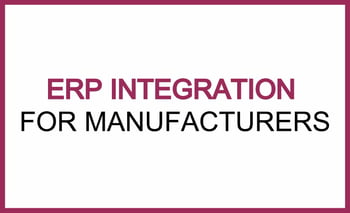
 How to prepare for integrating your ERP and B2B eCommerce site
How to prepare for integrating your ERP and B2B eCommerce siteToday’s manufacturing and distribution companies face a variety of challenges: pressure to increase productivity, lower operating costs, and manage ever-changing data needs. These days, data is king. Most companies do not have an issue generating data; problems arise when trying to access it and leverage it to positively position themselves within a competitive marketplace.
One of the best ways to harness the power of your data is to integrate your ERP with B2B eCommerce capabilities. By adding B2B eCommerce, you can greatly improve the effectiveness and efficiency of your back office processes. Using a sophisticated integration strategy, B2B companies can leverage the combined power of their ERP system and the online channel to simultaneously increase revenues and drive costs out of the organization.
Connecting an eCommerce system to a large and stable ERP, such as JD Edwards, allows for a seamless movement of data. However, the integration effort can be one of the most difficult parts of any implementation initiative. These projects require a robust and well-planned strategy that covers data flow, business logic, and an integration methodology.
The first item that should be addressed in an ERP and eCommerce integration project is to determine where each data element should be stored, and which system “owns” the data. You should consider specific items such as Customer Master Data, Item/Catalog data, and Customer Order Information.
After you decide on where each item should reside or if it should be shared, create a data map so that ownership is clearly defined. A great mantra to keep in mind is: “There can only be one source of the truth,” which will help you establish whether the eCommerce or ERP system should own the data.
After it’s determined whether the eCommerce or ERP system owns each piece of data, consider the business logic required to process an eCommerce order. ECommerce systems typically include functionality that is duplicated in the ERP, such as item pricing, taxing, and order processing. In considering these redundancies, you should look to keep a business function within the system that is best suited for processing that function.
A great example is tax calculations. In most instances, you can keep the tax calculation function of the ERP, as this is where all order processing occurs. However, if orders entered into the ERP are not taxed and the orders in the eCommerce system are taxed, then it make more sense to have the eCommerce system house the tax calculation logic.
Finally, you should look at integration methodologies. There are a host of options from which to choose, including a simple FTP process, an MQ Series, Web Services, and more. It’s often more beneficial to use an integration methodology that is already being used. This allows for consistency across all projects. We believe that this allows the development team to better understand and support new integration points.
Also, consider how close the data needs to be to real-time, as the closer it is to real-time, the more labor-intensive and costly the integration project becomes. We also like to keep things as simple and straightforward as possible. Over-complicating the integration simply makes everything that much harder, from programming it in the beginning to supporting it after go-live. If you’re keeping everything as simple as possible, it’s usually a good indication that you’ve chosen the best integration method.
Integrating a B2B eCommerce site to an ERP, such as JD Edwards, can be a challenge, but it’s worth the effort. Getting your back office and eCommerce site to communicate with each other will significantly improve sales interactions for your company. This allows the order management process to become seamless, and data and order information to be easily accessible.
In executing any integration, planning, organizing, and documenting a strategy allows for a much smoother project. So measure twice, cut once, and keep things simple.
Lorem ipsum dolor sit amet, consectetur adipiscing elit

For the past two decades, we've made it our business to help you work smarter. From commerce challenges to ERP customizations, we support the power of your big ideas by helping you work more strategically, more intuitively, and more efficiently.
2658 Scranton Road, Suite 3
Cleveland, Ohio 44113
216.369.3600
No Comments Yet
Let us know what you think